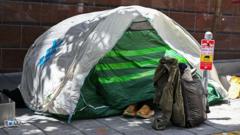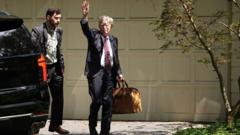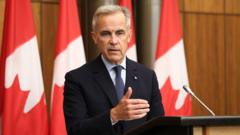With President Trump's federal push to criminalize homelessness in Washington, DC, parallels to San Francisco's aggressive strategies surface. While some claim these actions improve city aesthetics, advocates worry they merely shift problems rather than resolve them, affecting tens of thousands living on the streets.
A Tale of Two Cities: DC Mirrors San Francisco's Controversial Approach to Homelessness

A Tale of Two Cities: DC Mirrors San Francisco's Controversial Approach to Homelessness
As President Trump's administration adopts measures to clear homeless encampments in Washington, DC, comparisons with San Francisco's recent strategies reveal a complex dilemma surrounding homelessness management.
As visitors to San Francisco have long noted, the prevalence of homelessness and tent encampments creates a striking visual juxtaposition against the city's scenic beauty. Following an aggressive one-year crackdown, San Francisco's streets have undergone significant changes, but the conversation around homelessness remains contentious. In a surprising turn, President Donald Trump, known for his critiques of San Francisco’s homeless situation, has launched a similar campaign in the nation’s capital.
Initiating last week, federal authorities have begun removing homeless encampments in Washington DC, aligning their initiative with a broader trend seen throughout the United States. This move follows a landmark Supreme Court decision that affirmed the legality of issuing citations and making arrests for homeless camping, even in areas devoid of shelters. Just like localities in California, city and county administrations across the nation are following suit, enforcing penalties designed to deter public sleeping.
In California, Governor Gavin Newsom has prioritized the clear-out of encampments, resulting in significant transformations in cities like San Francisco. However, while some residents and business owners praise this strategy for enhancing the urban landscape, others vehemently argue about its practical effectiveness for solving homelessness.
The homelessness crisis became increasingly polarized nationwide during the pandemic. In urban centers such as San Francisco, the intertwining struggles of mental health, addiction, and a severe housing shortage have exacerbated the issue. The surge in visible poverty contrasted sharply with the tech industry's wealth created a palpable tension in the public consciousness. Creative approaches emerged, including the controversial app "SnapCrap," aimed at spotlighting the sanitation crisis on city streets.
Between October 2019 and April 2020, San Francisco witnessed a nearly three-fold surge in encampments, demonstrating the issue’s escalation during lockdowns when many fled shelters due to health fears. Over time, the city adopted aggressive housing measures, aiming to usher individuals indoors swiftly. Vivian Wan from Abode summarizes the paradox: “We were able to get a lot of people inside very quickly,” while residents criticize community housing developments.
The public discourse surrounding San Francisco's issues eventually turned into a punchline, notably within right-leaning media segments portraying a mass exodus of residents citing safety concerns. Meanwhile, after the Supreme Court’s ruling, then-Mayor London Breed initiated a tough approach to tent removals. Arrests and citations for illegal lodging surged beyond previous years.
While some see this policy as a necessary corrective, there are those in advocacy circles—like Chione Flegal of Housing California—who decry this criminalization as ineffective. "It's not actually doing anything to solve their challenges," she asserts.
As the number of arrests increased, so did the reported reduction in tents in San Francisco. However, data reveals a troubling trend: the population experiencing homelessness nationally continues to rise; estimates suggest over 8,300 homeless individuals in January 2024 alone, a worrying increase from previous years.
Supporters of Mayor Lurie’s policies maintain a dual-focus strategy that seeks to both deter outdoor living and provide pathways into shelters and supportive housing. The city allocated an extensive budget of $846 million to confront homelessness in the current fiscal year, with pledges of new shelter and treatment options.
Nevertheless, the situation remains delicate. Mayor Lurie emphasizes, “It’s not just homelessness. It’s a mental health and drug crisis on our streets.” He advocates for comprehensive solutions that extend beyond creating mere shelter beds. Recent polls show growing public optimism about these changes.
Experts agree that while efforts like adding crisis stabilization centers and reorganizing outreach teams are beneficial, there remains an underlying concern that such policies, particularly involving arrests and encampment sweeps, may simply displace the issue rather than resolve it. Dr. Margot Kushel remarks, “Removing someone's tent and belongings is distressing and destabilizing for people. There's never going to be a shortcut here.” As Washington DC adopts San Francisco's playbook, the debate over effective homeless solutions continues, raising vital questions about dignity, sustainability, and community responsibility.



















